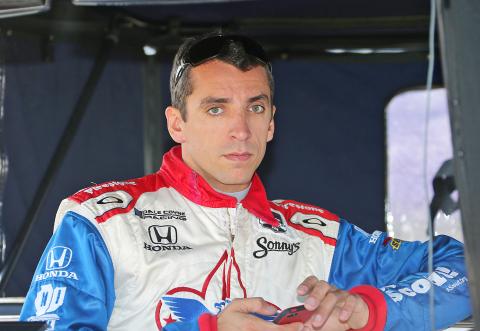IndyCar and Formula One are investigating the use of enclosed cockpits to improve driver safety following the recent death of Briton Justin Wilson, and could take a leaf out of the National Hot Rod Association’s (NHRA) book.
Former Formula One driver Wilson suffered severe head injuries from flying debris during a wreck in the closing laps of an IndyCar race in Pennsylvania last month and died in hospital the following day.
While none of the prototypes in IndyCar or Formula One has yet shown the benefits to clearly outweigh the disadvantages, the National Hot Rod Association’s premier division, Top Fuel, has been racing successfully with canopies since 2012.

Photo: AP
Don Schumacher Racing, which fields cars for series champions Tony Schumacher and Antron Brown, developed some of the original cockpit designs which are still in use today.
The fragile-looking, but monstrously powerful, Top Fuel racers develop at about 10,000 horsepower as they rocket down a 300m strip in less than four seconds, reaching top speeds of more than 320mph. They require parachutes to help them stop.
At those speeds a strike from anything — like the bouncing spring that struck Brazil’s Felipe Massa’s head at the Hungarian Grand Prix in 2009 — could be fatal to one of the NHRA drivers.
The canopy used by the drag racers closes over the existing car, and eight-time NHRA champion Schumacher would now never contemplate competing without one.
“I have hit three birds in my life in a Top Fuel,” Schumacher said.
“You hit one with [just] your helmet, it will kill you. I do not care what helmet you have on. It will blind you at 300mph ... and you are going to put it [the car] upside down,” he added.
Aside from the safety aspect, there is another benefit, according to Schumacher.
“The turbulence is taken away and the sound is so much better. I can hear the engine so much better because I am in a capsule,” he said.
According to Don Schumacher Racing, the cockpit protects the driver with “a hydraulic, fighter jet-type canopy that includes sides and a rear made of a combination of Kevlar and carbon fiber” that slips over an existing chassis.
“The canopy can be quickly released inside by the driver or at the rear by crew or safety workers. The canopy also carries a fire suppression system and fresh-air breathing system,” it added.
There has not been a fatality in more than 80 events in the NHRA’s Top Fuel since canopies were adopted in August 2012, and Brown is a firm believer after surviving a fiery wreck in May last year without suffering an injury.
“My car hit the wall, it knocked off the front wing, which hit right in the top center of the cockpit where my head was,” 2012 national champion Brown said about his crash in qualifying for the NHRA Summer Nationals at Atlanta Dragway in Georgia.
“If we only had a windshield, it would have hit me in the helmet and I would not be here telling you about it,” he added.
IndyCar safety measures have benefited from the work of Dr Stephen Olvey, a founding fellow of the International Automobile Federation Institute for Motor Sports Safety, and Dr Terry Trammell.
Massa’s injury in 2009, followed by the death of Henry Surtees, son of former Formula One world champion driver John Surtees, in a Formula 2 car, accelerated the search for answers, Olvey said.
“This led to more questions than answers, really,” said Olvey, who added that the jet canopy solution could create more problems if debris ricocheted off the canopy into grandstands following an accident. “It would be catastrophic.”
Olvey also said that IndyCars and Formula One cars race over long distances, and sometimes in driving rain, rather than in the short sprint of Top Fuel.
“So other issues to address could be ventilation, comfort and visibility,” he said.
For Olvey, speedy access after an IndyCar accident is a top priority as cockpits could trap the driver in the event of the car overturning.
“Anything that takes more time to get to the driver is time lost in resuscitative massage to save someone with an airway obstruction and breathing,” he said.
“No question that the head is the most vulnerable area of the driver, and fortunately these are freak accidents and are rare. There has been a cluster over the last five years and this is worrisome. There is probably a solution that has not been found yet,” he added.

Revelations of positive doping tests for nearly two dozen Chinese swimmers that went unpunished sparked an intense flurry of accusations and legal threats between the World Anti-Doping Agency (WADA) and the head of the US drug-fighting organization, who has long been one of WADA’s fiercest critics. WADA on Saturday said it was turning to legal counsel to address a statement released by US Anti-Doping Agency (USADA) CEO Travis Tygart, who said WADA and anti-doping authorities in China swept positive tests “under the carpet by failing to fairly and evenly follow the global rules that apply to everyone else in the world.” The

Taiwanese judoka Yang Yung-wei on Saturday won silver in the men’s under-60kg category at the Asian Judo Championships in Hong Kong. Nicknamed the “judo heartthrob” in Taiwan, the Olympic silver-medalist missed out on his first Asian Championships gold when he lost to Japanese judoka Taiki Nakamura in the finals. Yang defeated three opponents on Saturday to reach the final after receiving a bye through the round of 32. He first topped Laotian Soukphaxay Sithisane in the round of 16 with two seoi nage (over-the-shoulder throws), then ousted Indian Vijay Kumar Yadav in the quarter-finals with his signature ude hishigi sankaku gatame (triangular armlock). He

Rafael Nadal on Wednesday said the upcoming French Open would be the moment to “give everything and die” on the court after his comeback from injury in Barcelona was curtailed by Alex de Minaur. The 22-time Grand Slam title winner, back playing this week after three months on the sidelines, battled well, but eventually crumbled 7-5, 6-1 against the world No. 11 from Australia in the second round. Nadal, 37, who missed virtually all of last season, is hoping to compete at the French Open next month where he is the record 14-time champion. The Spaniard said the clash with De Minaur was

RALLY: It was only the second time the Taiwanese has partnered with Kudermetova, and the match seemed tight until they won seven points in a row to take the last set 10-2 Taiwan’s Chan Hao-ching and Russia’s Veronika Kudermetova on Sunday won the Porsche Tennis Grand Prix women’s doubles final in Stuttgart, Germany. The pair defeated Norway’s Ulrikke Eikeri and Estonia’s Ingrid Neel 4-6, 6-3, 10-2 in a tightly contested match at the WTA 500 tournament. Chan and Kudermetova fell 4-6 in the first set after having their serve broken three times, although they played increasingly well. They fought back in the second set and managed to break their opponents’ serve in the eighth game to triumph 6-3. In the tiebreaker, Chan and Kudermetova took a 3-0 lead before their opponents clawed back two points, but